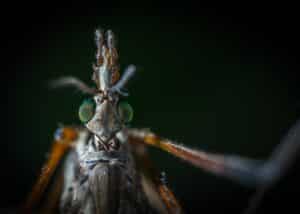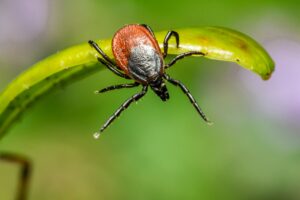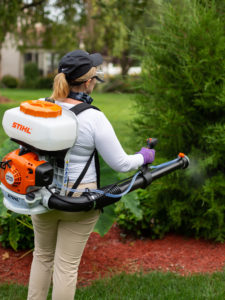First thing, I’m going to burst some bubbles…
Tick “nests” are not nests of any sort.
Not in the literal sense.
A tick nest by any other name...
You might be thinking:
“Wait, what? But what about that photo I saw on Facebook? The post was literally titled, “Check out this tick nest”. And it had like 40,000 shares. “
Here is the deal: critters that nest exhibit a labor cost input.
Whether it’s selecting a suitable site and building or digging the actual nest, incubating eggs, or feeding and protecting the young. Tick “nests” aren’t true nests as female ticks have a minimal labor input.
They do not choose a site (per se) to lay their eggs.
Note: There are lots of tick species in North America. In this blog post we will focus on two.
- Adult Deer and/or Blacklegged ticks
- Adult Lone star ticks.
These two ticks are the primary public health and pest species of interest in the North Eastern United States.
The Concept of a Tick "Nest"
A somewhat viral social media post made its way around in April 2019 which brought some attention to the “Tick Nest“ saga. Look familiar? The original post doesn’t seem to be available on social media but numerous media outlets picked it up. The photo was quickly debunked by various Entomologists noting it was not a tick egg cluster.

Another claim of a so-called tick “Nest“ can be found from Dundas, Ontario dating from May 2016.
Generally, a tick would not lay eggs on the surface of the leaf litter like this. Without constant humidity, the eggs will quickly dry out and die. Also without some sort of concealment, any eggs would likely become a food source for something else.
Needless to say, there are numerous reasons why these small black masses have not been identified as tick eggs.
It’s unlikely anyone would encounter tick eggs unless they are rustling around in the underbrush, moving a long-term leaf litter pile.
An actual group of eggs will just resemble a small reddish/brown clump that likely wouldn’t even be noticed.
Tick Life Cycle & Poppy Seeds
Deer Ticks
Adult deer ticks are a bit bigger with the males and females exhibiting sexual dimorphism, aka they look different. Females have a black dorsal shield (area just below the head) with a reddish brown alloscutum/body and are around 2.5mm On males the dorsal shield covers most of the alloscutum/body so they appear black in color. Generally males are around 2mm in size. A tick’s lifecycle incorporates incomplete metamorphosis.
Deer Tick Eggs
Larvae ticks have six legs and are less than .5mm in size.
You may be more familiar with the next stage, the nymph. In May of 2019, the CDC put out a photo reminding everyone its tick season which gained quite a bit of attention as it showcased a poppy seed muffin with a surprise. The nymph is about the size of a poppy seed or 1mm, and has eight legs which the CDC showcased rather well, but it may have dismayed some from eating poppy seeds for a bit.
Adult deer ticks are a bit bigger with the males and females exhibiting sexual dimorphism, aka they look different. Females have a black dorsal shield (area just below the head) with a reddish brown alloscutum/body and are around 2.5mm On males the dorsal shield covers most of the alloscutum/body so they appear black in color. Generally males are around 2mm in size.
Tick Hosts and Feeding Behavior
The white-tailed deer is the predominant host for deer/ blacklegged ticks and Lone star ticks.
Essentially the host gives the tick the sole option of where the host was when the tick finished feeding and was able to drop off.
Multi-host ticks will drop off a host when the host itself is active, there really is not much of any ‘thought’ processes involved on the ticks end.
Ticks have no eyes so they use various sensor organs to detect changes in light, humidity, movement, and pick up on other triggers in the environment. Female ticks that have a full blood meal can’t move quickly, or far.
After the female ticks drops off the host they will slowly make their way under the leaf litter or other ideally protected location to lay their egg. As they aren’t very mobile they find what they deem a suitable spot and shortly after laying the eggs the female tick will die.
The Real Culprit
Lone star tick larvae are likely the real cause behind many other claimed “nests“ encounters. In the video above we can see numerous lone star tick larvae I came across while hiking. They are hard to miss as the larvae are about the size of a newspaper period. I say it’s likely Lone star tick larvae as the culprit as deer tick larvae don’t target large animals as hosts and therefore rarely feed on humans. Lone star tick larvae will cluster together on top of the leaf litter, or grass awaiting hosts of all sizes.
According to the CDC Lone star ticks can be found from Texas east to Florida. A northern zone from Southeastern Nebraska and most of Iowa eastward through lower New York, Massachusetts and southern parts of Maine (https://www.cdc.gov/ticks/maps/lone_star_tick.pdf). Often the resulting bites can be misidentified as chiggers.
A single female Lone star tick can lay around 5000 eggs. Not all of them survive and successfully feed but it’s not at all uncommon to encounter between 25-500 tick larvae at a time, often clumped together co-questing on a leaf or plant stem. Larvae will move around over time to locate good questing sites, then retreat to humid microclimates to rehydrate. So again, there really is no nest – just a moving amorphous blob of hungry tick larvae. Once they get on a host they are rather quick to move and feed. Often by the time you end your walk, hike or other outdoor adventure the tick larvae will have fed and dropped off back onto the ground. To put this time period into perspective: larvae ticks can finish feeding and drop back off in within an hour.
With this in mind it’s not too hard to see why they often go unnoticed until you’re left itching for days or weeks on end. The only early indicator that something might be a miss would be orange/brown flecks that quickly radiate outward – in search of a feeding area. This can be difficult to see depending on the color of your clothing, even if you are checking regularly. If you’re out where the larvae tend to roam, whether you’re hiking or doing some tick surveillance of your own permethrin treated clothing or repellents labeled for ticks will work wonders for you.






